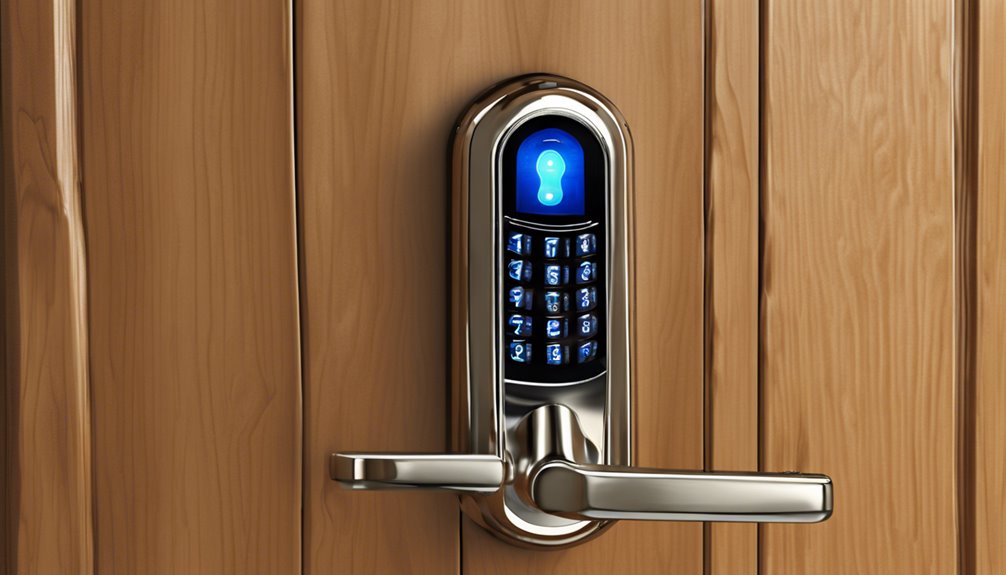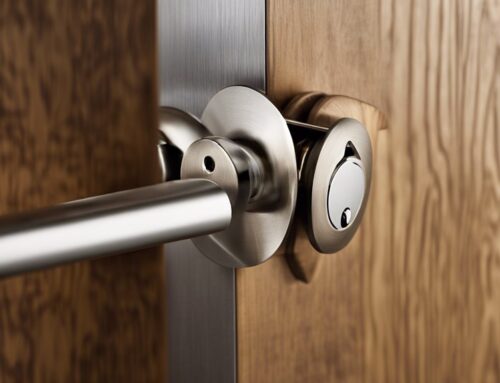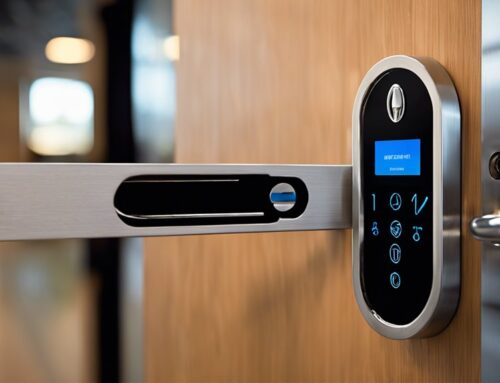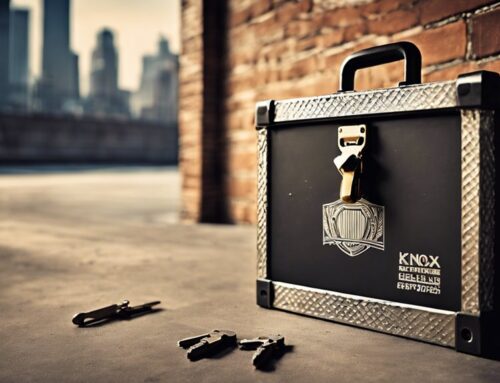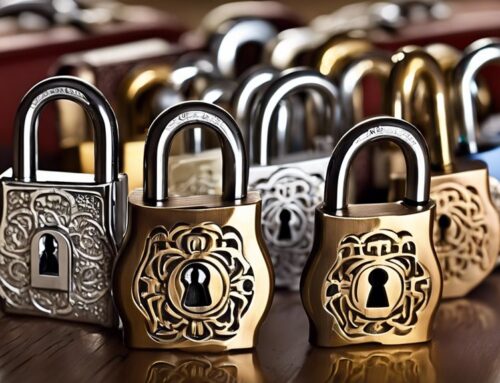Imagine you’re managing a busy office where employees need access at varying times. Electronic locks provide that flexibility, integrating technology that offers numerous access methods like keypads and biometrics. But how do these systems compare to traditional locks, and what security features should you consider? The answers to these questions can greatly impact your approach to security and convenience.
Key Takeaways
- Electronic locks utilize advanced mechanisms, including biometric sensors and mobile app integrations, enhancing security and convenience over traditional locks.
- Types of electronic locks include magnetic, keypad, RFID, Bluetooth, and biometric options, providing varied access control and security features.
- Enhanced user convenience features include remote management, temporary access codes, audit trails, and backlit keypads for visibility in low light.
- Potential risks involve reliance on technology, hacking threats, and encryption vulnerabilities, necessitating strong passwords and regular security updates.
- Future trends focus on biometrics, smart home integrations, AI-driven security, and improved encryption standards for better data protection.
Electronic Lock Technology
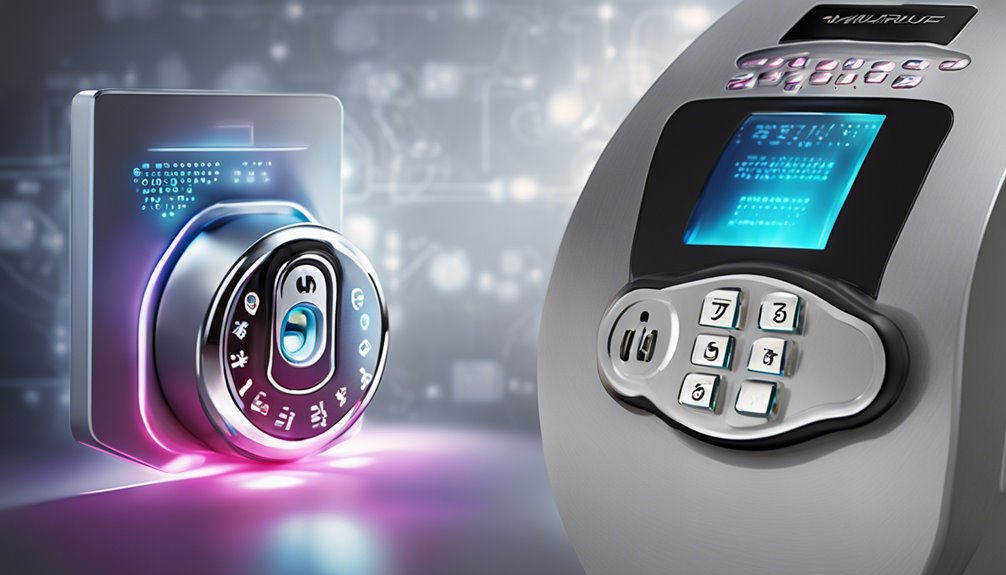
When you consider the importance of security in today’s world, electronic lock technology emerges as a sophisticated solution for modern access control.
This technology leverages advanced mechanisms like keypad entry, biometric sensors, and mobile app integrations to create a secure and efficient locking system. By replacing traditional mechanical locks with digital alternatives, you enhance not only security but also convenience. Smart locks, such as the Aqara Smart Lock U100, offer multiple access methods for increased versatility.
Electronic locks allow for remote access management, real-time monitoring, and customizable security protocols, providing reduced vulnerability to unauthorized entry.
The integration of encryption algorithms guarantees that communication between the locking mechanism and access credentials remains secure. Additionally, evaluating the pros and cons of smart locks is crucial in determining their suitability for your specific needs.
As you explore electronic lock technology, it’s essential to understand its underlying principles to maximize its potential for safeguarding your property.
Types of Electronic Locks
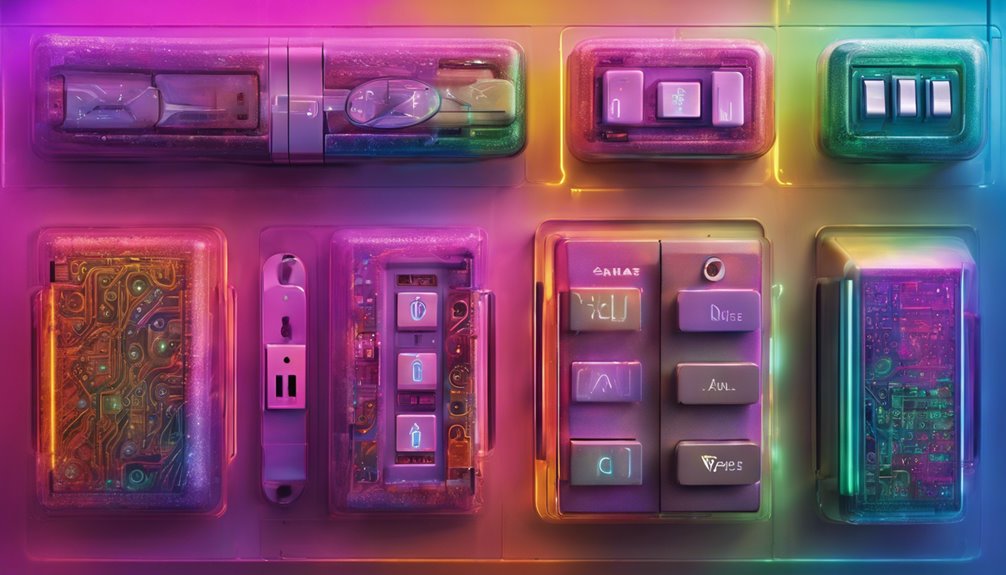
When exploring electronic locks, you’ll encounter a variety of mechanisms suited for different security needs. Magnetic locks offer a robust solution for high-security areas, while keypad locks provide convenient access control. Additionally, the integration of RFID and Bluetooth technology enhances user experience and flexibility in access management. Some electronic locks also feature biometric authentication, which adds an extra layer of security by using unique physical traits for access. Understanding Bluetooth locks can further improve your smart home integration and enhance overall security.
Magnetic Lock Mechanism
Magnetic locks, or electromagnetic locks (often referred to as maglocks), operate on the principle of magnetic attraction to secure doors and entry points effectively.
When voltage is applied, the electromagnet creates a strong magnetic field that pulls a metal plate attached to the door, holding it securely against the frame.
You’ll find maglocks particularly advantageous in high-security environments due to their robust holding force and minimal mechanical wear. Furthermore, they’re fail-safe; in case of power failure, they release, ensuring a means of egress. This advanced design contributes to their effectiveness in thwarting unauthorized access, similar to the security features found in high-security locks.
However, you must consider appropriate installation, as improper alignment can diminish effectiveness. Understanding power requirements and having the right backup systems are vital factors in maximizing their efficacy and reliability. Additionally, high-security locks can provide an extra layer of security when used in conjunction with maglocks, making them a formidable option for safeguarding property.
Keypad Lock Features
Electronic locks come in various forms, and keypad locks are among the most popular due to their user-friendly operation and enhanced security features.
Keypad locks utilize a numerical entry system, allowing you to easily manage access without traditional keys. You can program multiple user codes, making it simple to grant or revoke access to different individuals as needed. Additionally, smart locks support temporary access codes for visitors, improving access management.
Many models offer backlit keypads for visibility in low light, and some include advanced features like temporary codes for visitors. You should also look for options with auto-lock functions for added security.
Additionally, certain keypad locks incorporate tamper alerts, ensuring that you’re immediately informed if unauthorized access attempts occur. This technology is part of a broader category of smart lock features that maximize security and accessibility.
This combination of convenience and security makes keypad locks a reliable choice for today’s demands.
RFID and Bluetooth Usage
As technology evolves, RFID and Bluetooth have emerged as popular alternatives to traditional locking mechanisms.
RFID locks utilize radio-frequency identification, enabling you to open doors with a simple swipe of a keycard or fob. This technology offers frictionless entry, ideal for high-traffic areas, especially in environments where regular lock replacement is crucial for maintaining security.
Bluetooth locks, on the other hand, grant access through a paired smartphone app, allowing you to open doors remotely or share access easily with others.
Both methods enhance security with encrypted signals, reducing the risk of unauthorized access.
You’ll appreciate that RFID is typically used in institutional settings, while Bluetooth is favored for residential applications. Signs your lock needs replacement can also become apparent, ensuring you maintain the security of your premises.
Familiarizing yourself with both will guarantee informed choices for your lock selection, maximizing convenience and security.
Security Features Overview
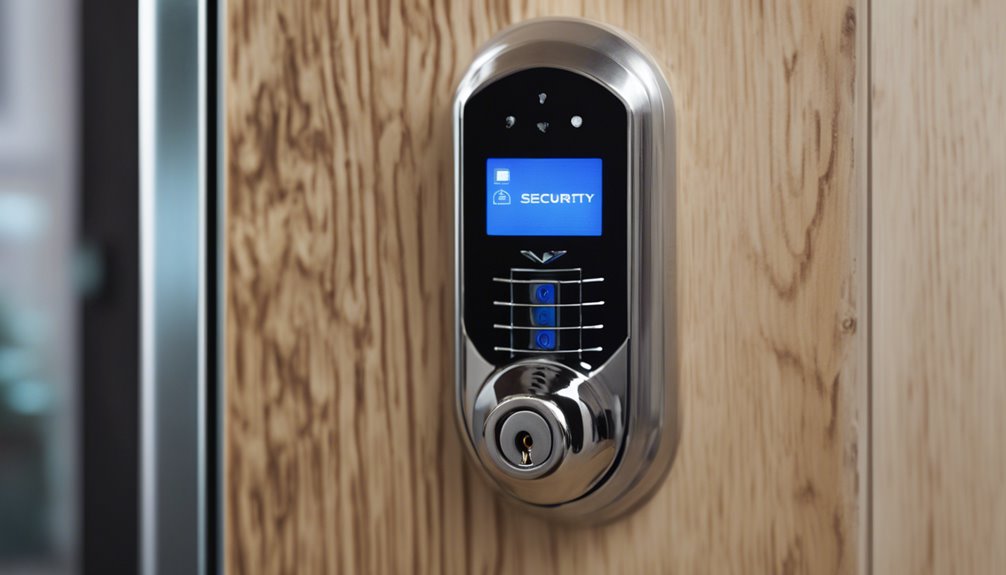
While evaluating security measures for locking systems, understanding the security features of electronic locks is essential.
These locks often incorporate multifactor authentication, integrating keypads, biometrics, and mobile access for heightened security. Payload encryption protects data transmission, preventing unauthorized interception, while rolling codes guarantee that the access code changes with each use, reducing vulnerability to replay attacks. This technology is part of the burgeoning trend toward smart locks which enhance security through advanced features.
Additionally, many electronic locks feature tamper alerts, notifying you of unauthorized attempts to breach the system. Auto-lock functions reinforce security by guaranteeing doors are secured without manual intervention.
Remote monitoring capabilities allow for real-time oversight of access activities. Understanding these features equips you with the knowledge to choose a lock that meets your security requirements effectively, providing superior protection for your property. Moreover, the integration of monitored systems enhances security by providing real-time alerts and immediate action in response to suspicious activities.
Advantages of Electronic Locks
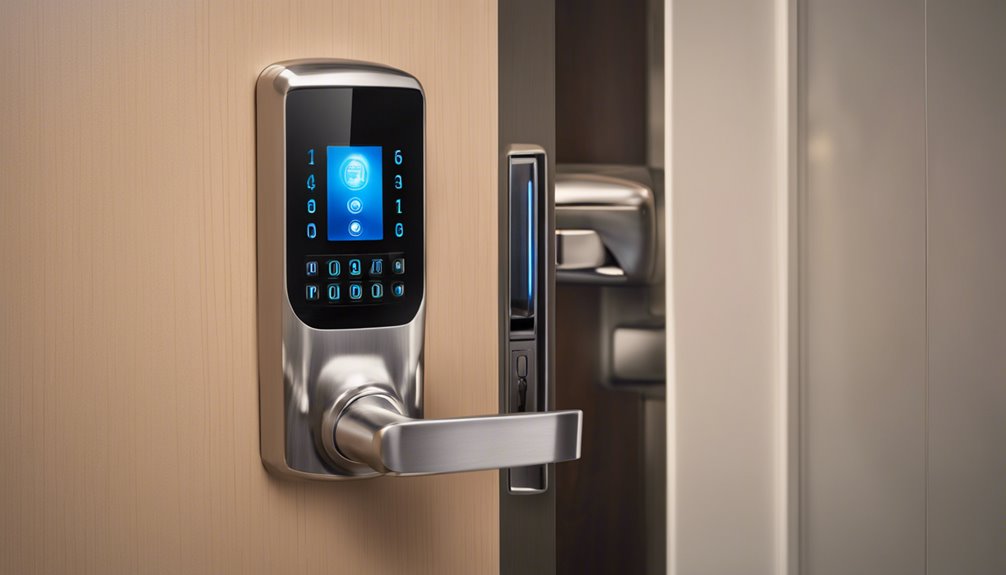
Electronic locks offer significant advantages, particularly in enhanced security measures and increased user convenience.
By utilizing advanced technology, these locks provide robust protection against unauthorized access while simplifying the user experience. High-security locks like August Smart Lock exemplify the integration of convenience and technology in modern security solutions. You’ll find that the integration of features like keyless entry and remote access makes managing security both efficient and effective. Additionally, digital keyless locks provide an innovative solution that eliminates the risks associated with lost or stolen keys.
Enhanced Security Measures
When considering the need for advanced security solutions, electronic locks offer important advantages over traditional mechanical systems. These systems utilize encryption protocols, making unauthorized access considerably more difficult.
You benefit from real-time monitoring capabilities, enabling you to track entry and exit activities, which enhances your overall security posture. Additionally, many electronic locks feature tamper alerts, notifying you of any unauthorized attempts to breach your system.
Furthermore, the use of biometric data, such as fingerprints, guarantees that only authorized users gain access. Unlike traditional keys, which can be lost or duplicated, electronic locks provide customizable access levels and the ability to revoke access instantly.
This level of control and auditability is essential for maintaining a robust security environment. Moreover, advanced detection from integrated security systems can alert you to unusual activities, further bolstering the effectiveness of electronic locks.
Increased User Convenience
Many homeowners and businesses appreciate the user convenience that electronic locks provide. These locks eliminate the need for physical keys, reducing the risk of loss or theft. You can effortlessly manage access for multiple users through smartphones or key fobs, enhancing operational efficiency. Additionally, many electronic locks offer features like remote locking and granting access, programmable access codes, and audit trails.
Here’s a quick comparison highlighting key conveniences:
| Feature | Benefit | User Experience |
|---|---|---|
| Keyless Entry | Hassle-free access | No lost keys |
| Remote Access | Control from anywhere | Manage entries easily |
| Customizable Codes | Tailored access | Convenient user management |
| Audit Logs | Security monitoring | Track who accessed |
| Easy Installation | User-friendly setup | Minimal technical skills needed |
Potential Risks to Consider
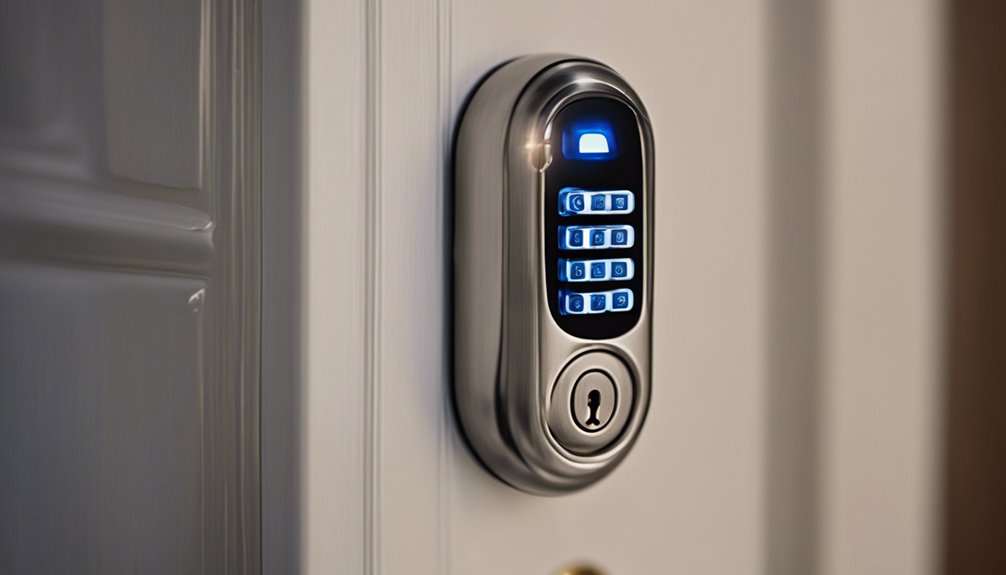
While electronic locks offer convenience and advanced security features, potential risks warrant careful consideration. One significant risk is reliance on technology, which can fail due to power outages or software glitches.
Additionally, hacking threats loom large, as poorly secured systems may allow unauthorized access. Your lock’s vulnerability may increase if it uses weak encryption or outdated protocols.
Furthermore, lost keys or compromised passwords can lead to unauthorized entry, elevating your security concerns.
It’s essential to understand that some electronic locks may also lack the physical robustness of traditional locks, making them attractive to determined intruders.
Ultimately, maintaining security requires awareness of these risks, alongside diligent selection and management of your electronic locking systems.
Best Practices for Use
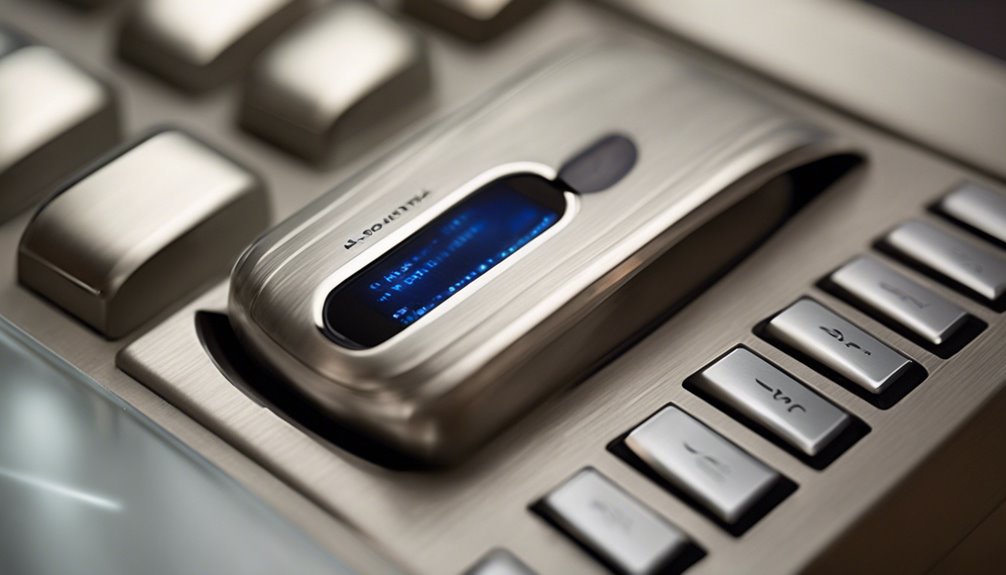
To guarantee ideal security with electronic locks, follow five essential best practices.
First, regularly update your lock’s firmware to protect against vulnerabilities.
Second, use strong, unique access codes for each user and change them periodically.
Finally, integrate your electronic lock with a thorough security system for enhanced monitoring and control.
- Establish access logs: Monitor who enters and exits, aiding in identifying unauthorized access.
- Create contingency plans: Prepare for power outages or technical failures to maintain access security.
- Educate users: Make sure everyone understands how to properly use the locks to prevent misuse.
Implementing these practices will maximize the effectiveness of your electronic locking system, ensuring a robust security framework.
Future of Electronic Locking Systems
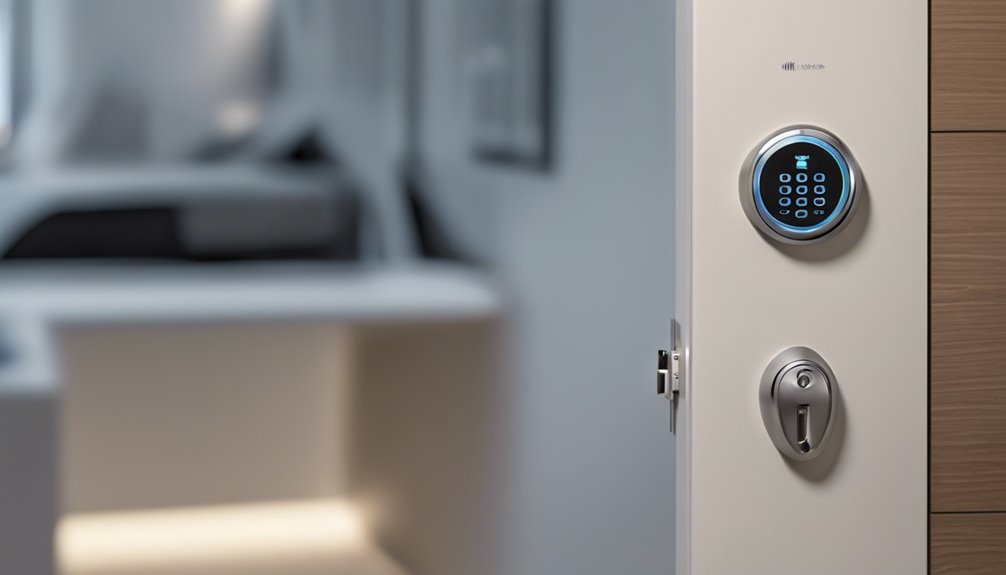
As security practices evolve, the future of electronic locking systems is set to become more advanced and user-friendly. Expect a surge in biometrics, like facial recognition and fingerprint scanning, enhancing security through unique identifiers.
Integration with smart home ecosystems will streamline access controls, allowing you to manage locks remotely via your smartphone. Furthermore, artificial intelligence will optimize security algorithms, greatly reducing vulnerabilities.
You’ll also see increased emphasis on encryption standards, ensuring data integrity during transmission. As vulnerabilities are exploited, manufacturers will fortify systems with real-time monitoring and alerts, providing immediate responses to breaches.
Ultimately, the shift towards seamless connectivity and advanced authentication will define the next generation of electronic locks, making your security not only stronger but also more convenient.
Frequently Asked Questions
How Long Do Electronic Locks Typically Last Before Needing Replacement?
Electronic locks typically last between 5 to 15 years, depending on factors like usage, environment, and maintenance.
If you’re using a high-quality lock from a reputable manufacturer, you’ll generally see the upper end of that lifespan.
Regular battery replacements and occasional software updates can extend functionality.
Pay attention to any signs of wear or malfunction, as these may indicate it’s time for a replacement to maintain security and reliability.
Can Electronic Locks Be Installed on Any Type of Door?
When you envision transforming your entryway into a high-tech fortress, you might wonder if electronic locks fit your door.
Generally, these locks can be installed on most doors, including wood, metal, and fiberglass, as long as they meet certain size and structural requirements.
However, you’ll need to account for the thickness and style of your door, ensuring it’s compatible with the specific electronic lock model you’re considering for maximum security and functionality.
What Happens During a Power Outage With Electronic Locks?
During a power outage, electronic locks may become non-functional, especially if they rely solely on electricity for operation.
However, many models feature backup systems, such as battery power or key access, ensuring you can still open your door.
It’s essential to check your lock’s specifications.
You should consider having alternative entry methods, like physical keys or emergency batteries, so you’re prepared for unexpected power disruptions and maintain your home’s security.
Are Electronic Locks Compatible With Smart Home Systems?
If you’re looking to elevate your home security, electronic locks often play nicely with smart home systems.
They seamlessly integrate with platforms like Google Home or Amazon Alexa, providing you with remote access and control.
With these locks, you can open your door from anywhere, set up alerts, and monitor entry points in real time.
Just verify the compatibility of your chosen lock with your existing system for a flawless experience.
How Do You Reset an Electronic Lock if You Forget the Code?
To reset your electronic lock after forgetting the code, start by locating the reset button, usually found on the back or inside the lock.
Press and hold this button until the light indicator flashes, signaling you can enter a new code.
Input your desired code, ensuring it meets security requirements.
Finally, test the new code several times to confirm it works consistently.
Always refer to the manufacturer’s instructions for specific reset procedures.
Conclusion
To sum up, electronic locks act as the sentinels of modern security, guarding your space with advanced technology. By understanding their diverse types, robust security features, and potential risks, you can make informed choices to enhance your safety. As you integrate these systems into your home or business, remember to follow best practices for peak security. With the future of electronic locking systems on the horizon, you’ll be better equipped to embrace this evolving landscape.

